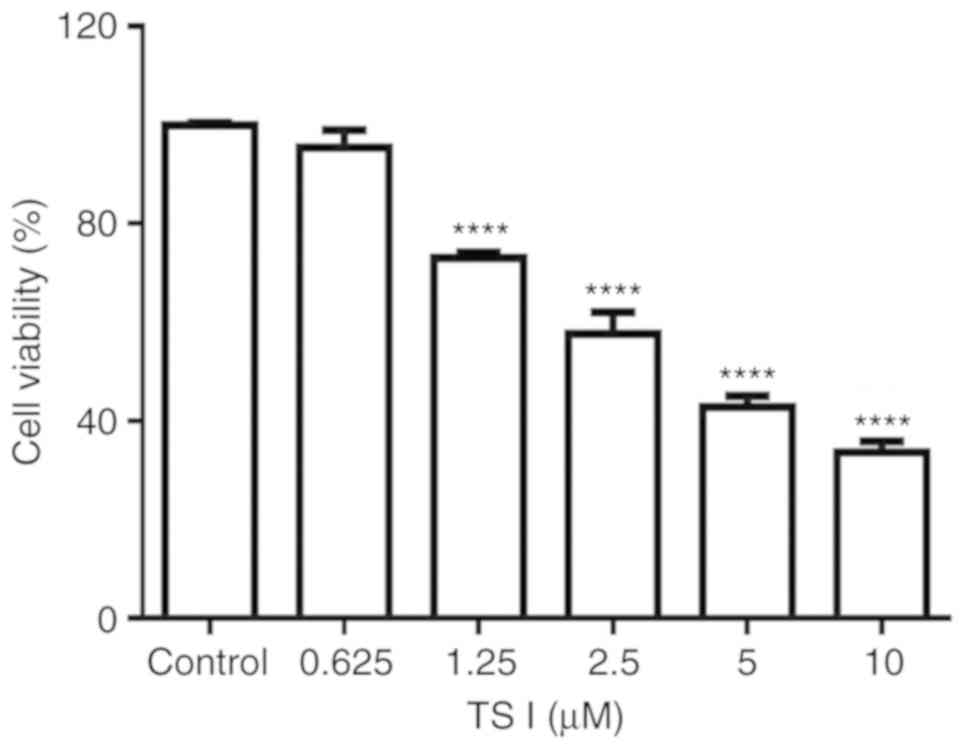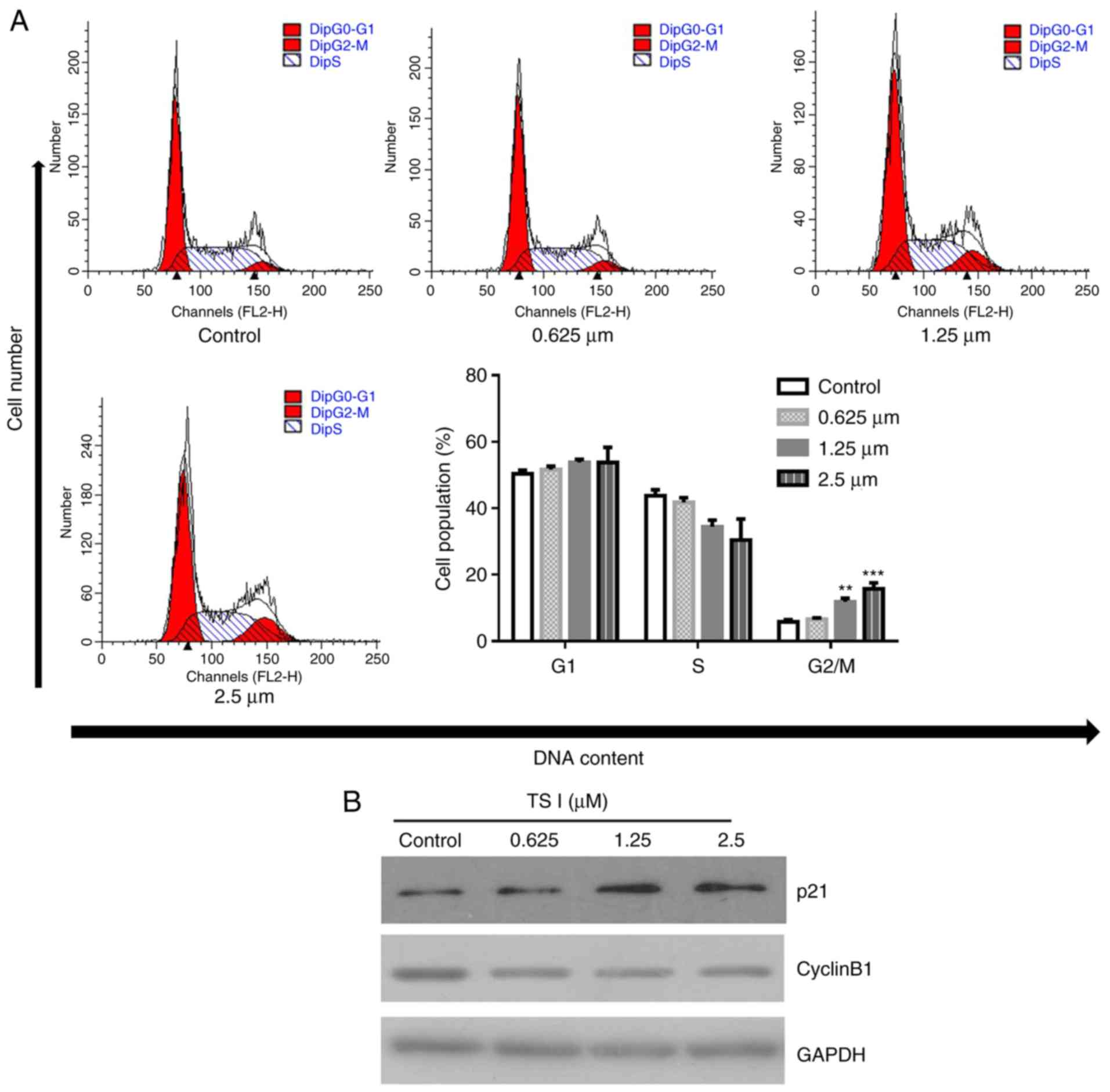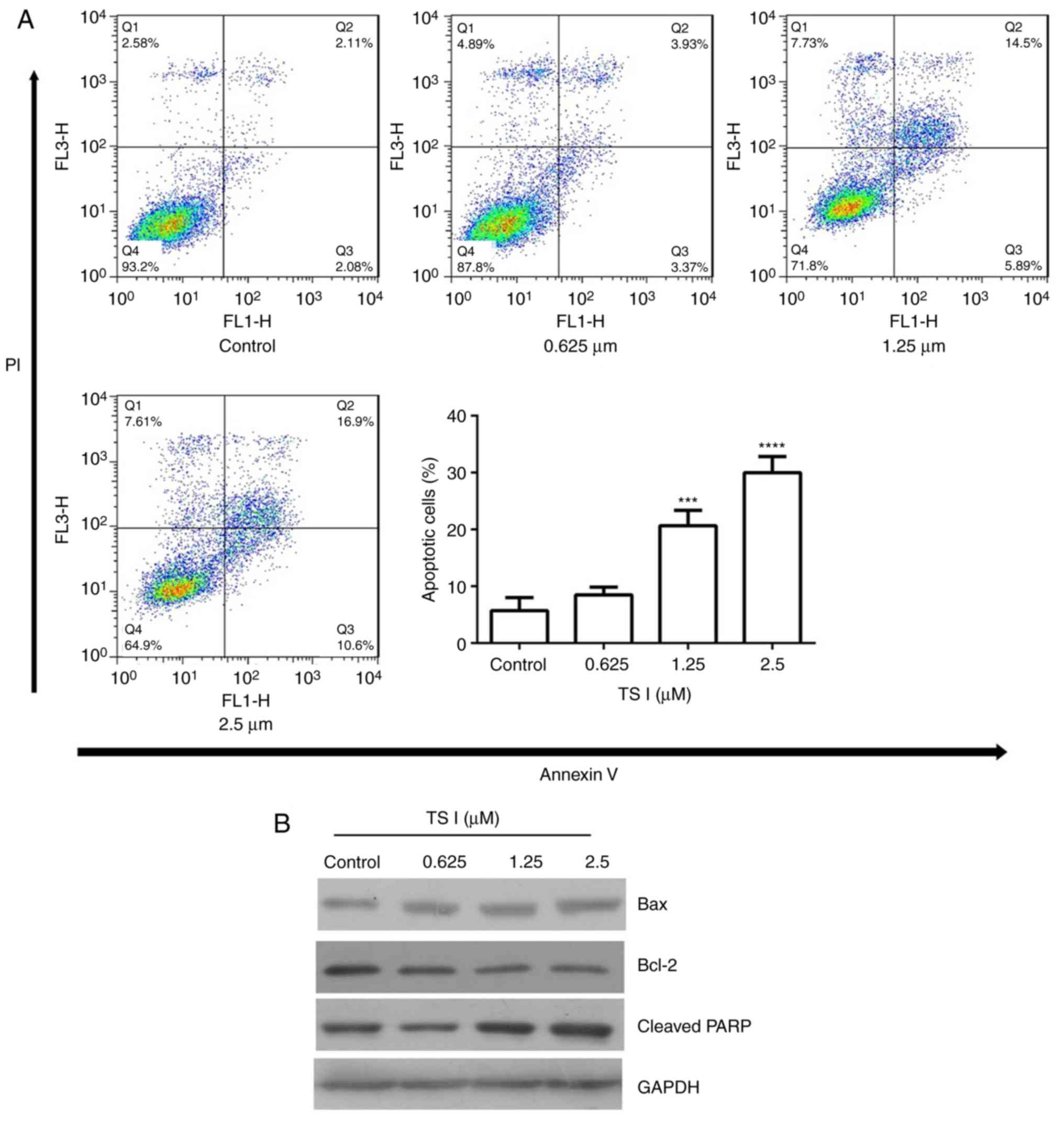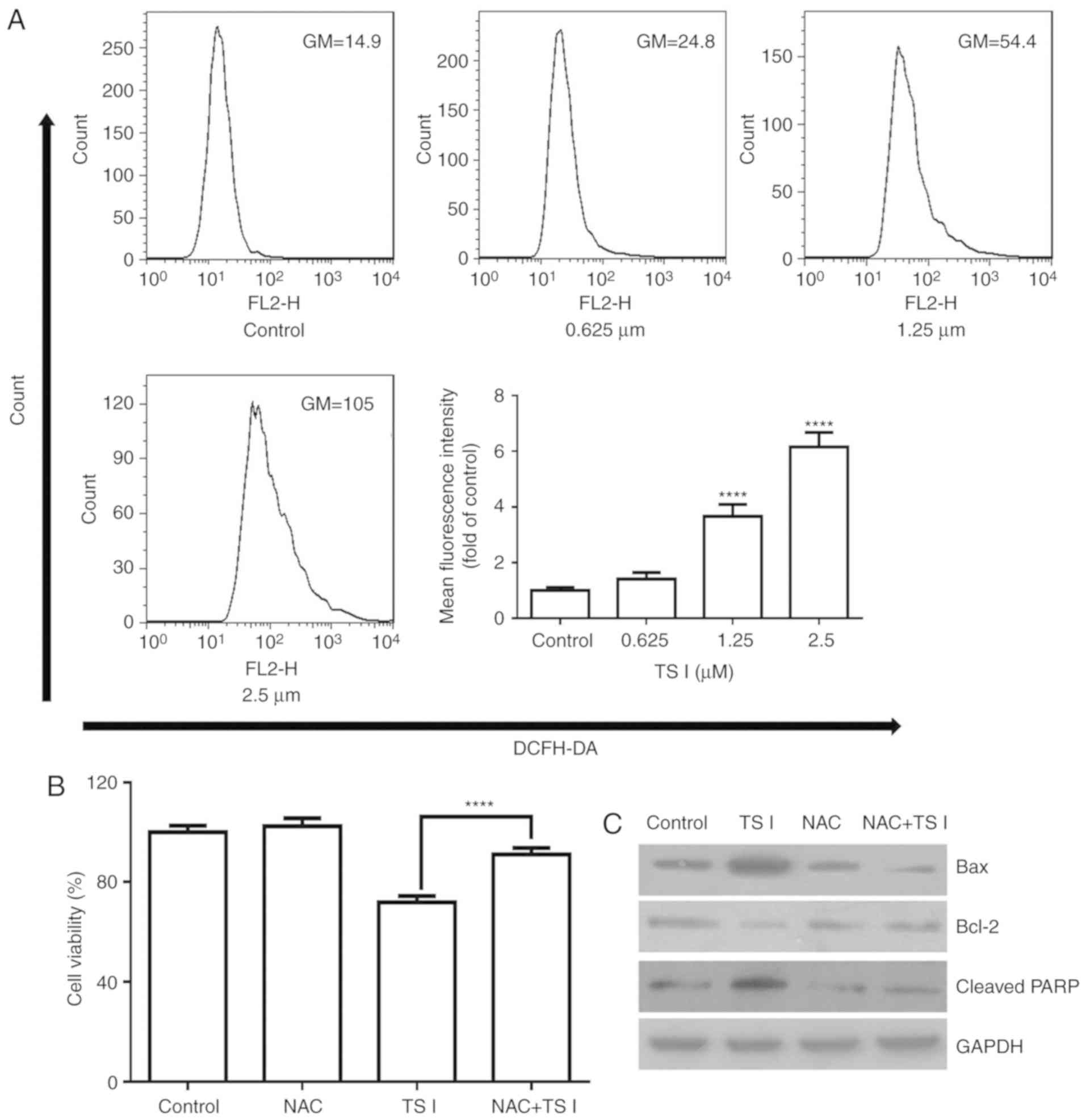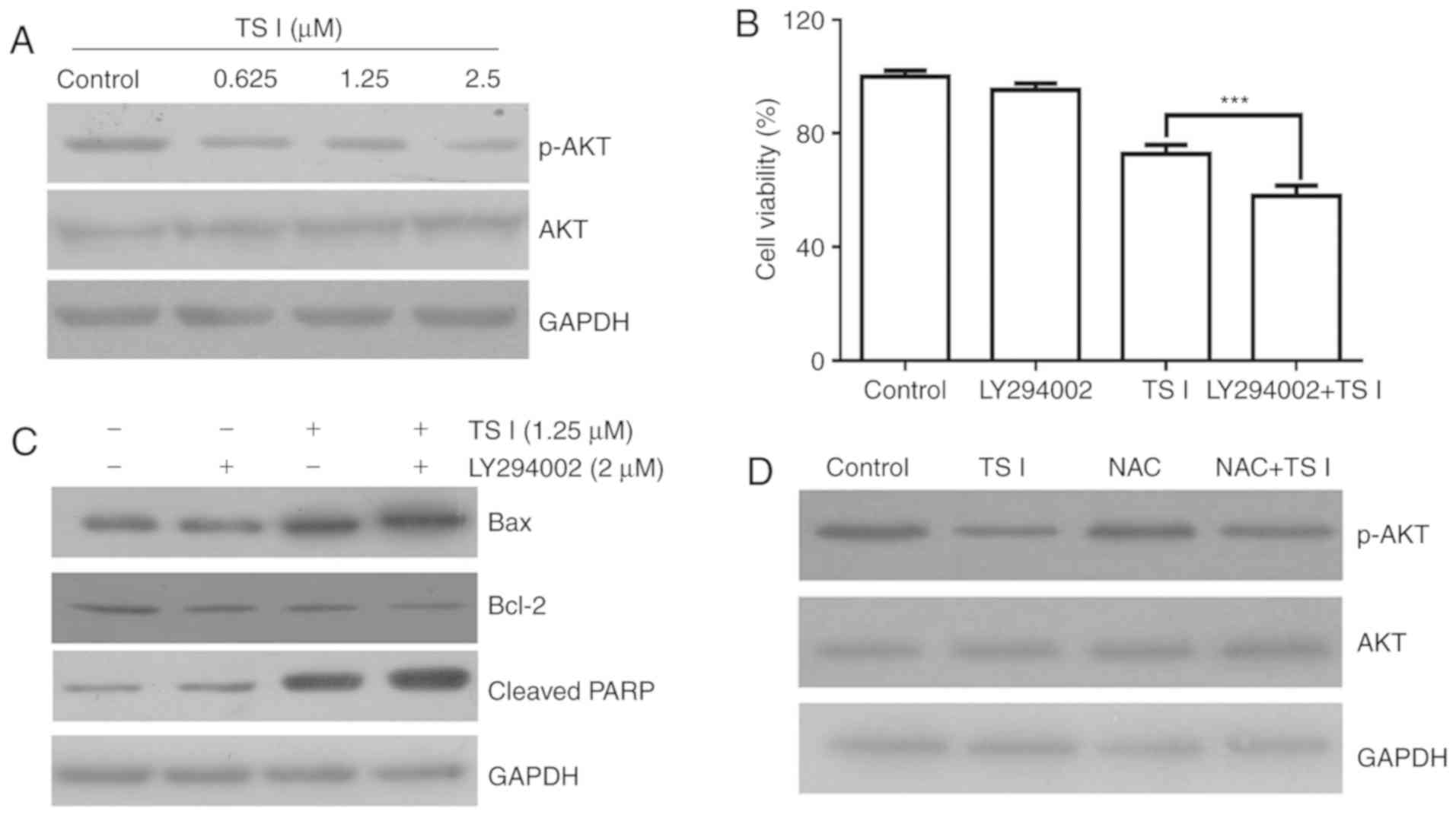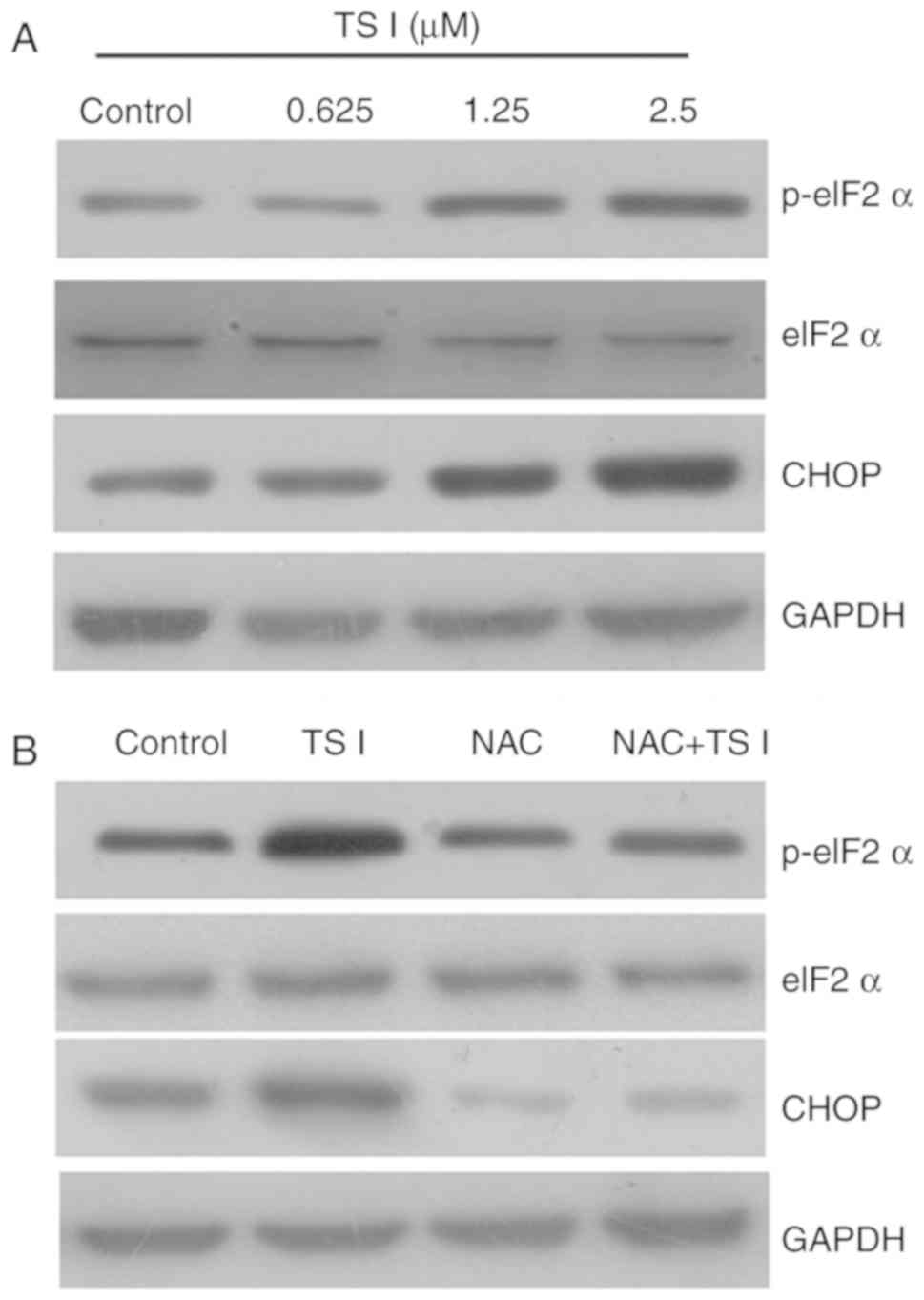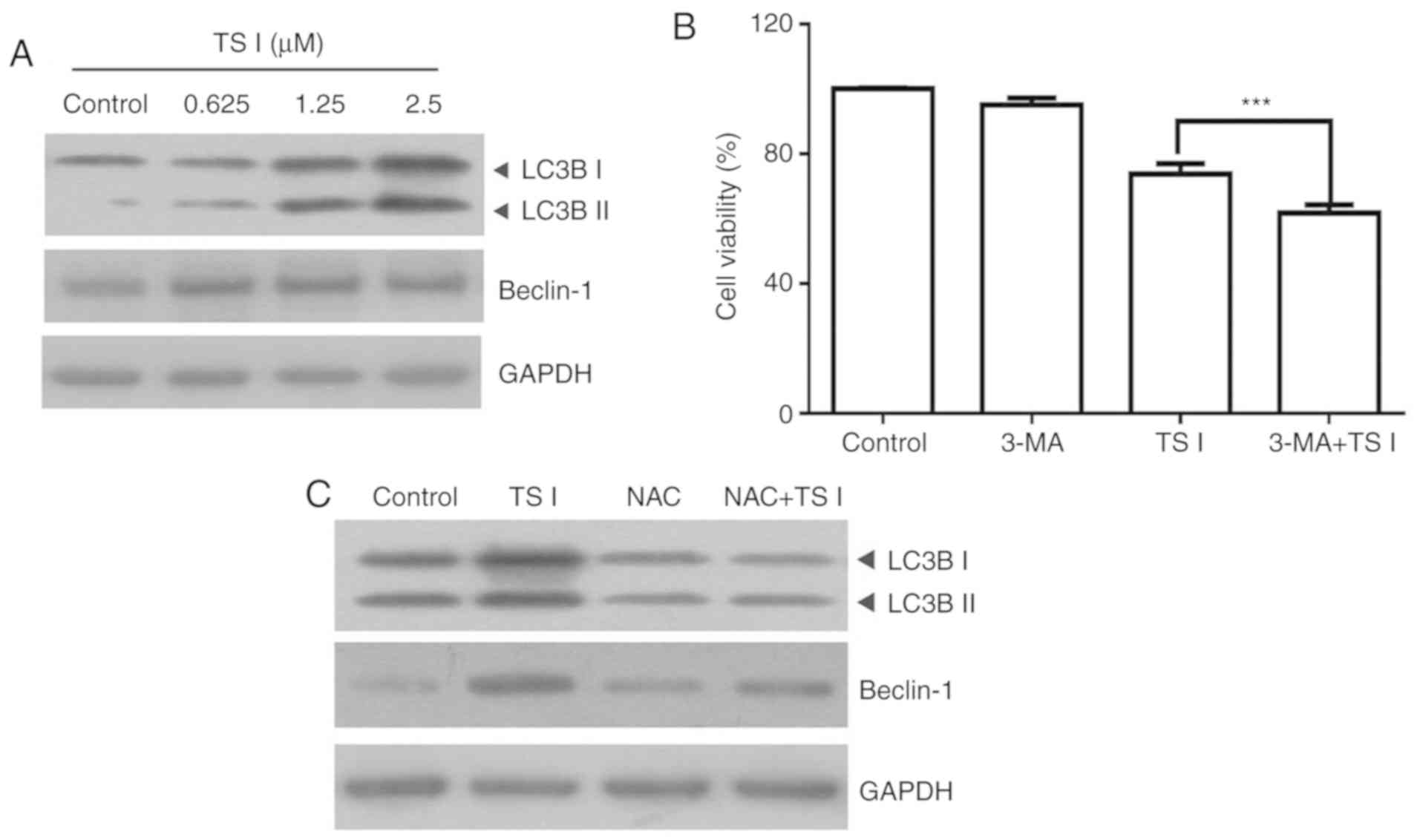|
1
|
Jiang Y and Uhrbom L: On the origin of
glioma. Ups J Med Sci. 117:113–121. 2012. View Article : Google Scholar : PubMed/NCBI
|
|
2
|
Cloughesy TF, Cavenee WK and Mischel PS:
Glioblastoma: From molecular pathology to targeted treatment. Annu
Rev Pathol. 9:1–25. 2014. View Article : Google Scholar
|
|
3
|
Stupp R, Mason WP, van den Bent MJ, Weller
M, Fisher B, Taphoorn MJ, Belanger K, Brandes AA, Marosi C, Bogdahn
U, et al: Radiotherapy plus concomitant and adjuvant temozolomide
for glioblastoma. N Engl J Med. 352:987–996. 2005. View Article : Google Scholar : PubMed/NCBI
|
|
4
|
Neyns B, Tosoni A, Hwu WJ and Reardon DA:
Dose-dense temozolomide regimens: Antitumor activity, toxicity, and
immunomodulatory effects. Cancer. 116:2868–2877. 2010. View Article : Google Scholar : PubMed/NCBI
|
|
5
|
Fish JM, Welchons DR, Kim YS, Lee SH, Ho
WK and Antzelevitch C: Dimethyl lithospermate B, an extract of
Danshen, suppresses arrhythmogenesis associated with the Brugada
syndrome. Circulation. 113:1393–1400. 2006. View Article : Google Scholar : PubMed/NCBI
|
|
6
|
Chang PN, Mao JC, Huang SH, Ning L, Wang
ZJ, On T, Duan W and Zhu YZ: Analysis of cardioprotective effects
using purified Salvia miltiorrhiza extract on isolated rat hearts.
J Pharmacol Sci. 101:245–249. 2006. View Article : Google Scholar : PubMed/NCBI
|
|
7
|
Tian XH and Wu JH: Tanshinone derivatives:
A patent review (January 2006-September 2012). Expert Opin Ther
Pat. 23:19–29. 2013. View Article : Google Scholar
|
|
8
|
Wang W, Li J, Ding Z, Li Y, Wang J, Chen S
and Miao J: Tanshinone I inhibits the growth and metastasis of
osteosarcoma via suppressing JAK/STAT3 signalling pathway. J Cell
Mol Med. 23:6454–6465. 2019. View Article : Google Scholar : PubMed/NCBI
|
|
9
|
Kim DH, Shin EA, Kim B, Shim BS and Kim
SH: Reactive oxygen species-mediated phosphorylation of p38
signaling is critically involved in apoptotic effect of Tanshinone
I in colon cancer cells. Phytother Res. 32:1975–1982. 2018.
View Article : Google Scholar : PubMed/NCBI
|
|
10
|
Jing X, Xu Y, Cheng W, Guo S, Zou Y and He
L: Tanshinone I induces apoptosis and pro-survival autophagy in
gastric cancers. Cancer Chemother Pharmacol. 77:1171–1181. 2016.
View Article : Google Scholar : PubMed/NCBI
|
|
11
|
Wang L, Wu J, Lu J, Ma R, Sun D and Tang
J: Regulation of the cell cycle and PI3K/Akt/mTOR signaling pathway
by tanshinone I in human breast cancer cell lines. Mol Med Rep.
11:931–939. 2015. View Article : Google Scholar
|
|
12
|
Nizamutdinova IT, Lee GW, Son KH, Jeon SJ,
Kang SS, Kim YS, Lee JH, Seo HG, Chang KC and Kim HJ: Tanshinone I
effectively induces apoptosis in estrogen receptor-positive (MCF-7)
and estrogen receptor-negative (MDA-MB-231) breast cancer cells.
Int J Oncol. 33:485–491. 2008.PubMed/NCBI
|
|
13
|
Su CC, Chen GW and Lin JG: Growth
inhibition and apoptosis induction by tanshinone I in human colon
cancer Colo 205 cells. Int J Mol Med. 22:613–618. 2008.PubMed/NCBI
|
|
14
|
Lu M, Wang C and Wang J: Tanshinone I
induces human colorectal cancer cell apoptosis: The potential roles
of Aurora A-p53 and survivin-mediated signaling pathways. Int J
Oncol. 49:603–610. 2016. View Article : Google Scholar : PubMed/NCBI
|
|
15
|
Gdowski A, Panchoo M, Treuren TV and Basu
A: Emerging therapeutics for targeting Akt in cancer. Front Biosci
(Landmark Ed). 21:757–768. 2016. View
Article : Google Scholar
|
|
16
|
Lien EC, Dibble CC and Toker A: PI3K
signaling in cancer: Beyond AKT. Curr Opin Cell Biol. 45:62–71.
2017. View Article : Google Scholar : PubMed/NCBI
|
|
17
|
Atkins RJ, Dimou J, Paradiso L, Morokoff
AP, Kaye AH, Drummond KJ and Hovens CM: Regulation of glycogen
synthase kinase-3 beta (GSK-3β) by the Akt pathway in gliomas. J
Clin Neurosci. 19:1558–1563. 2012. View Article : Google Scholar : PubMed/NCBI
|
|
18
|
Jiang L, Wang C, Lei F, Zhang L, Zhang X,
Liu A, Wu G, Zhu J and Song L: miR-93 promotes cell proliferation
in gliomas through activation of PI3K/Akt signaling pathway.
Oncotarget. 6:8286–8299. 2015.PubMed/NCBI
|
|
19
|
Ji L, Zhong B, Jiang X, Mao F, Liu G, Song
B, Wang CY, Jiao Y, Wang JP, Xu ZB, Li X and Zhan B: Actein induces
autophagy and apoptosis in human bladder cancer by potentiating
ROS/JNK and inhibiting AKT pathways. Oncotarget. 8:112498–112515.
2017. View Article : Google Scholar
|
|
20
|
Ahn KI, Choi EO, Kwon DH, HwangBo H, Kim
MY, Kim HJ, Ji SY, Hong SH, Jeong JW, Park C, et al: Induction of
apoptosis by ethanol extract of Citrus unshiu Markovich peel in
human bladder cancer T24 cells through ROS-mediated inactivation of
the PI3K/Akt pathway. Biosci Trends. 11:565–573. 2017. View Article : Google Scholar : PubMed/NCBI
|
|
21
|
Gorrini C, Harris IS and Mak TW:
Modulation of oxidative stress as an anticancer strategy. Nat Rev
Drug Discov. 12:931–947. 2013. View
Article : Google Scholar : PubMed/NCBI
|
|
22
|
Zhao Q, Liu Y, Zhong J, Bi Y, Liu Y, Ren
Z, Li X, Jia J, Yu M and Yu X: Pristimerin induces apoptosis and
autophagy via activation of ROS/ASK1/JNK pathway in human breast
cancer in vitro and in vivo. Cell Death Discov. 5:1252019.
View Article : Google Scholar : PubMed/NCBI
|
|
23
|
Liu Y, Kang X, Niu G, He S, Zhang T, Bai
Y, Li Y, Hao H, Chen C, Shou Z and Li B: Shikonin induces apoptosis
and prosurvival autophagy in human melanoma A375 cells via
ROS-mediated ER stress and p38 pathways. Artif Cells Nanomed
Biotechnol. 47:626–635. 2019. View Article : Google Scholar : PubMed/NCBI
|
|
24
|
Yuan X, Wang B, Yang L and Zhang Y: The
role of ROS-induced autophagy in hepatocellular carcinoma. Clin Res
Hepatol Gastroenterol. 42:306–312. 2018. View Article : Google Scholar : PubMed/NCBI
|
|
25
|
Vermeulen K, Van Bockstaele DR and
Berneman ZN: The cell cycle: A review of regulation, deregulation
and therapeutic targets in cancer. Cell Prolif. 36:131–149. 2003.
View Article : Google Scholar : PubMed/NCBI
|
|
26
|
Chao JI, Kuo PC and Hsu TS:
Down-regulation of survivin in nitric oxide-induced cell growth
inhibition and apoptosis of the human lung carcinoma cells. J Biol
Chem. 279:20267–20276. 2004. View Article : Google Scholar : PubMed/NCBI
|
|
27
|
Zhang J, Su G, Lin Y, Meng W, Lai JKL,
Qiao L, Li X and Xie X: Targeting cyclin-dependent kinases in
gastrointestinal cancer therapy. Discov Med. 27:27–36.
2019.PubMed/NCBI
|
|
28
|
Bloom J and Cross FR: Multiple levels of
cyclin specificity in cell-cycle control. Nat Rev Mol Cell Biol.
8:149–160. 2007. View Article : Google Scholar : PubMed/NCBI
|
|
29
|
Yu CY, Jerry Teng CL, Hung PS, Cheng CC,
Hsu SL, Hwang GY and Tzeng YM: Ovatodiolide isolated from
Anisomeles indica induces cell cycle G2/M arrest and apoptosis via
a ROS-dependent ATM/ATR signaling pathways. Eur J Pharmacol.
819:16–29. 2017. View Article : Google Scholar : PubMed/NCBI
|
|
30
|
Lee MH, Cho Y, Kim DH, Woo HJ, Yang JY,
Kwon HJ, Yeon MJ, Park M, Kim SH, Moon C, et al: Menadione induces
G2/M arrest in gastric cancer cells by down-regulation of CDC25C
and proteasome mediated degradation of CDK1 and cyclin B1. Am J
Transl Res. 8:5246–5255. 2016.
|
|
31
|
Stivala LA, Cazzalini O and Prosperi E:
The cyclin-dependent kinase inhibitor p21CDKN1A as a target of
anti-cancer drugs. Curr Cancer Drug Targets. 12:85–96. 2012.
View Article : Google Scholar
|
|
32
|
Starostina NG and Kipreos ET: Multiple
degradation pathways regulate versatile CIP/KIP CDK inhibitors.
Trends Cell Biol. 22:33–41. 2012. View Article : Google Scholar :
|
|
33
|
Gong FR, Wu MY, Shen M, Zhi Q, Xu ZK, Wang
R, Wang WJ, Zong Y, Li ZL, Wu Y, et al: PP2A inhibitors arrest G2/M
transition through JNK/Sp1- dependent down-regulation of CDK1 and
autophagy-dependent up-regulation of p21. Oncotarget.
6:18469–18483. 2015. View Article : Google Scholar : PubMed/NCBI
|
|
34
|
Wang LH, Jiang XR, Chen GL, Guo W, Zhang
JY, Cui LJ, Li HH, Li M, Liu X, Yang JY and Wu CF: Anti-tumor
activity of SL4 against breast cancer cells: Induction of
G2/M arrest through modulation of the MAPK-dependent p21
signaling pathway. Sci Rep. 6:364862016. View Article : Google Scholar
|
|
35
|
Tung YT, Chen HL, Lee CY, Chou YC, Lee PY,
Tsai HC, Lin YL and Chen CM: Active component of danshen (Salvia
miltiorrhiza Bunge), Tanshinone I, attenuates lung tumorigenesis
via inhibitions of VEGF, cyclin A, and cyclin B expressions. Evid
Based Complement Alternat Med. 2013:3192472013. View Article : Google Scholar : PubMed/NCBI
|
|
36
|
Liu G, Pei F, Yang F, Li L, Amin AD, Liu
S, Buchan JR and Cho WC: Role of autophagy and apoptosis in
non-small-cell lung cancer. Int J Mol Sci. 18:E3672017. View Article : Google Scholar : PubMed/NCBI
|
|
37
|
Croce CM and Reed JC: Finally, an
apoptosis-targeting therapeutic for cancer. Cancer Res.
76:5914–5920. 2016. View Article : Google Scholar : PubMed/NCBI
|
|
38
|
Cheng YL, Lee SC, Lin SZ, Chang WL, Chen
YL, Tsai NM, Liu YC, Tzao C, Yu DS and Harn HJ: Anti-proliferative
activity of Bupleurum scrozonerifolium in A549 human lung cancer
cells in vitro and in vivo. Cancer Lett. 222:183–193. 2005.
View Article : Google Scholar : PubMed/NCBI
|
|
39
|
Manning BD and Toker A: AKT/PKB signaling:
Navigating the network. Cell. 169:381–405. 2017. View Article : Google Scholar : PubMed/NCBI
|
|
40
|
Spangle JM, Roberts TM and Zhao JJ: The
emerging role of PI3K/AKT-mediated epigenetic regulation in cancer.
Biochim Biophys Acta Rev Cancer. 1868:123–131. 2017. View Article : Google Scholar : PubMed/NCBI
|
|
41
|
Kello M, Kulikova L, Vaskova J, Nagyova A
and Mojzis J: Fruit peel polyphenolic extract-induced apoptosis in
human breast cancer cells is associated with ROS production and
modulation of p38MAPK/Erk1/2 and the akt signaling pathway. Nutr
Cancer. 69:920–931. 2017. View Article : Google Scholar : PubMed/NCBI
|
|
42
|
Jovaisas E, Koch MA, Schafer A, Stauber M
and Lowenthal D: LAV/HTLV-III in 20-week fetus. Lancet. 2:11291985.
View Article : Google Scholar : PubMed/NCBI
|
|
43
|
Moeinifard M, Hassan ZM, Fallahian F,
Hamzeloo-Moghadam M and Taghikhani M: Britannin induces apoptosis
through AKT-FOXO1 pathway in human pancreatic cancer cells. Biomed
Pharmacother. 94:1101–1110. 2017. View Article : Google Scholar : PubMed/NCBI
|
|
44
|
Yaoi X, Lu B, Lu C, Bai Q, Yan D and Xu H:
Taraxerol induces cell apoptosis through A mitochondria-mediated
pathway in HeLa cells. Cell J. 19:512–519. 2017.PubMed/NCBI
|
|
45
|
Li C, Wang Y, Wang C, Yi X, Li M and He X:
Anticancer activities of harmine by inducing a pro-death autophagy
and apoptosis in human gastric cancer cells. Phytomedicine.
28:10–18. 2017. View Article : Google Scholar : PubMed/NCBI
|
|
46
|
Kim MJ, Kwon SB, Kim MS, Jin SW, Ryu HW,
Oh SR and Yoon DY: Trifolin induces apoptosis via extrinsic and
intrinsic pathways in the NCI-H460 human non-small cell lung-cancer
cell line. Phytomedicine. 23:998–1004. 2016. View Article : Google Scholar : PubMed/NCBI
|
|
47
|
Thiagarajan S, Arapoc DJ, Husna Shafie N,
Keong YY, Bahari H, Adam Z and Ei T: Momordica charantia (Indian
and Chinese Bitter Melon) extracts inducing apoptosis in human lung
cancer cell line A549 via ROS-mediated mitochodria injury. Evid
Based Complement Alternat Med. 2019:28215972019. View Article : Google Scholar :
|
|
48
|
N B, Chandrashekar KR, Prabhu A and Rekha
PD: Tetrandrine isolated from Cyclea peltata induces cytotoxicity
and apoptosis through ROS and caspase pathways in breast and
pancreatic cancer cells. In Vitro Cell Dev Biol Anim. 55:331–340.
2019. View Article : Google Scholar : PubMed/NCBI
|
|
49
|
Li Q, Zhang J, Liang Y, Mu W, Hou X, Ma X
and Cao Q: Tanshinone l exhibits anticancer effects in human
endometrial carcinoma HEC-1-A cells via mitochondrial mediated
apoptosis, cell cycle arrest and inhibition of JAK/STAT signalling
pathway. J BUON. 23:1092–1096. 2018.PubMed/NCBI
|
|
50
|
Song X, Wang Z, Liang H, Zhang W, Ye Y, Li
H, Hu Y, Zhang Y, Weng H, Lu J, et al: Dioscin induces gallbladder
cancer apoptosis by inhibiting ROS-mediated PI3K/AKT signalling.
Int J Biol Sci. 13:782–793. 2017. View Article : Google Scholar : PubMed/NCBI
|
|
51
|
Huang H, Xie H, Pan Y, Zheng K, Xia Y and
Chen W: Plumbagin triggers ER stress-mediated apoptosis in prostate
cancer cells via induction of ROS. Cell Physiol Biochem.
45:267–280. 2018. View Article : Google Scholar : PubMed/NCBI
|
|
52
|
Kim SM, Lee HM, Hwang KA and Choi KC:
Benzo(a)pyrene induced cell cycle arrest and apoptosis in human
choriocar-cinoma cancer cells through reactive oxygen
species-induced endoplasmic reticulum-stress pathway. Food Chem
Toxicol. 107:339–348. 2017. View Article : Google Scholar : PubMed/NCBI
|
|
53
|
Yang Y, Zhang Y, Wang L and Lee S:
Levistolide a induces apoptosis via ROS-mediated ER stress pathway
in colon cancer cells. Cell Physiol Biochem. 42:929–938. 2017.
View Article : Google Scholar : PubMed/NCBI
|
|
54
|
Zhao D, Tong L, Zhang L, Li H, Wan Y and
Zhang T: Tanshinone II A stabilizes vulnerable plaques by
suppressing RAGE signaling and NF-κB activation in
apolipoprotein-E-deficient mice. Mol Med Rep. 14:4983–4990. 2016.
View Article : Google Scholar : PubMed/NCBI
|
|
55
|
Geng YD, Zhang L, Wang GY, Feng XJ, Chen
ZL, Jiang L and Shen AZ: Xanthatin mediates G2/M cell
cycle arrest, autophagy and apoptosis via ROS/XIAP signaling in
human colon cancer cells. Nat Prod Res. 27:1–5. Dec 27–2018.Epub
ahead of print. View Article : Google Scholar
|
|
56
|
Wang B, Zhou TY, Nie CH, Wan DL and Zheng
SS: Bigelovin, a sesquiterpene lactone, suppresses tumor growth
through inducing apoptosis and autophagy via the inhibition of mTOR
pathway regulated by ROS generation in liver cancer. Biochem
Biophys Res Commun. 499:156–163. 2018. View Article : Google Scholar : PubMed/NCBI
|
|
57
|
Gao H, Sun W, Zhao W, Hao W, Leung CH, Lu
J and Chen X: Total tanshinones-induced apoptosis and autophagy via
reactive oxygen species in lung cancer 95D cells. Am J Chin Med.
43:1265–1279. 2015. View Article : Google Scholar : PubMed/NCBI
|















